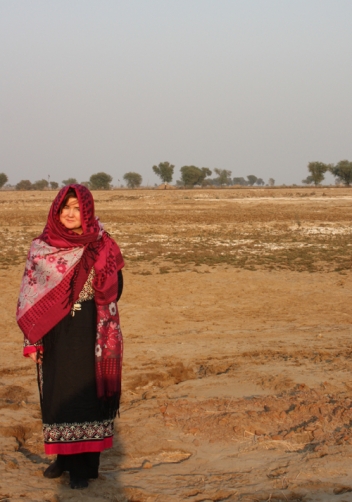 Two weeks ago, the UN’s Food and Agriculture Organisation (FAO) announced that global food prices were at their highest level on record.
Two weeks ago, the UN’s Food and Agriculture Organisation (FAO) announced that global food prices were at their highest level on record.
Then a few days ago, a major UK government report on the global food system, the Global Food and Farming Futures report, concluded that the existing system fails half the people on the planet. It warned that if drastic action is not taken the price of food will rise sharply in coming decades, which in turn will lead to increased conflict.
Global food prices will double
The report, involving 400 scientists from 34 countries, predicts a doubling in real terms for maize, which feeds 300 million in Africa, between 30-80% rise in the cost of rice and 40-60% rise in the cost of wheat.
Here in Pakistan, rice and roti are the staple foods, particularly of the poor.
BBC Radio 4’s Today programme had an extensive interview with the UK government’s chief scientific adviser, John Beddington, who oversaw the report. I’m listening to the podcast of the interview in my room in Islamabad.
“It is not just science and technology, trade and prices – it is much bigger than that” and he cites varying factors such as poverty and economic growth, water and energy shortages, and climate change and biodiversity loss.
“The world has not recognised that this linking is essential,” he says.
I’m no economist or scientist but it’s really not that hard to link the issues, is it?
Pakistan floods destroyed farmlands
A few days later, I’m in a rural village on the outskirts of Jacobabad in Sindh province of Pakistan, an area devastated by last year’s floods.
70-year-old Khandzadi tells me: “these are the worst floods in my lifetime, even in my father’s lifetime, and the rumours are they’ll happen more often”.
Most of the people living in this village are landless haree (peasants). They work on the land around the village which belongs to large-scale landowners.
Most of the land was destroyed by the floods and very little is recovered enough for cultivation. Some of the floodwater in fact is still around, stagnating and creating breeding grounds for mosquitos.
Most of the villagers believe it will take 1 to 2 years for the land to recover enough for them to re-plant. In the meantime they’ll look for alternative incomes.
In normal times, they buy rice, wheat grain and vegetable seeds, and everyone – men, women and children cultivate the land. When it’s time to harvest, they keep one third and two-thirds is handed to the landlord.
“We haven’t eaten meat for four months”
66-year old widow, Sarah, tell me: “Before the floods we ate twice a day, and had better food because we had poultry, cows and goats. They floods killed all the livestock. Now we, including the children, eat once a day. Mainly rice, roti, and some vegetables. We haven’t eaten meat for four months, and we drink tea without milk. Even the children don’t get milk”.
The lack of protein is evident in the red-tinged hair that many of the children display.
“ Food is very expensive now, sometimes 50% higher than before the flood. Some land can be cultivated already, but the yields are low so this pushes up the price. And the floods came in the rice harvest, so we lost everything from that harvest and won’t see another harvest for at least one more year.”
Global food prices high but wages stay low
While food prices rise, wages certainly aren’t rising to match them. The men from the village travel each day to Jacobobad looking for work as labourers and earning daily wages of 250 rupees (£2).
And if the gap between increased food prices and mens earnings isn’t wide enough, when we look at the women’s earnings, we see a gaping hole. Sarah has four adult daughters none of whom can marry as she cannot afford the dowries;
“My sewing machine was lost in the floods so I borrowed this one from a friend. I do the sewing of rilli (traditional patchwork quilts) and my daughters do embroidery. This is our only income now so we work all day at it. We do about ten to twelve hours a day on it, until its dark. The embroidery we sell on to a broker (middle man).
“The middle man pays us 55 rupees (40p) for one piece. It takes 4 to 5 days to make this one piece. The broker probably sells it on for 500 rupees. We depend on this person, we can’t do anything about his price.”
“Cash grant gave me money for food and medicine”
Sarah received a cash grant of 10,000 rupees (£73) from HelpAge. “It was “unconditional” so I could spent it on anything – I spent it on the necessities – rice flour, vegetables, and medicine for my condition. My medicine costs 1,300 rupee (£9.50) for 8 days. If I don’t take the medicine I am in severe pain. And if I’m I pain I can’t work.
“Most of the time I need to borrow money for the medicine. So the money from HelpAge for medicine helped me keep working. The HelpAge grant, winter kits and hygiene kits are all we’ve got. Without this, we would have had so little”.
This might be one village in one flood-affected district in a province of Pakistan. It’s also a microcosm for the global village, let down by policies that have failed the poor around the world.
As the world’s scientists and politicians argue the best ways forward to feeding the world, the poorest and most vulnerable to climate change and food insecurity continue to try to feed themselves.
Despite floods, drought, migration, disease, these older landless farmers keep working. What choice have they?
